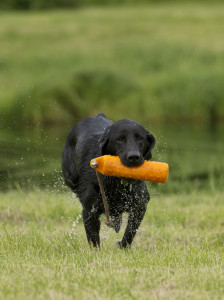 Something you need to understand about retrievers before you start training is that these dogs were born to hunt. Of course, having a retriever with hunting pedigree gives them even a bit of a genetic edge. However, even the best duck hunting dogs have to be trained and have their skills refined before they can head out into the field or on the water with you.
Something you need to understand about retrievers before you start training is that these dogs were born to hunt. Of course, having a retriever with hunting pedigree gives them even a bit of a genetic edge. However, even the best duck hunting dogs have to be trained and have their skills refined before they can head out into the field or on the water with you.
Start with Basic Training on the Leash
Before you get into hunting specifics, basic training is a good place to start. One of the first things you should work on with your duck hunting dog is the leash then graduate to a check cord. (Remember when training, always praise the dog when he does well, just don’t overdo it. A quick treat or a pet on the shoulders will do the trick)
- Sit-Command – attach the leash to your dog’s collar. Have the dog stand next to you and gently pull up on the leash. Doing this will naturally cause the dog to sit, which is when you give a firm “Sit” command. Repeat these process several times and eventually the dog will associate the command with the action of sitting.
- Stay-Command – once the dog takes to sitting, it is time to enforce the stay command. Put your hand directly in the face of the dog and give the “Stay” command. Now, drop his leash and take a few steps away, all the while holding your hand up as you did initially. If the dog tries to come to you, place him back in the original position and give the “Stay” command again. Keep repeating this process while increasing the distance after each successful attempt.
- Come-Command – when the dog has mastered the Stay command, he must now learn the “Come” command. Attach a long rope (check cord) to the dog’s collar and move about 20-25 feet away after giving the “Stay” command. Once you are at this distance, gently tug on the rope while giving the “Come” command. When the dog comes to you, reward him and bring him back to the starting position, repeating the process and increasing the distance each time. If the dog breaks the command before you call him, bring him back as you did with the Stay command until he is able to repeat this without problems.
- Heel-Command – reattach the original leash to the dog’s collar and have the dog walk by your side, this should be taught with the dog on your off side (opposite side that you carry your firearm) . While the dog is walking by your side, give the “Heel” command so he associates this with the command. If the dog tries to lead you, walk in the opposite direction (do not just jerk the leash). This will cause the dog to return to you side. When he is back in position, give the “Heel” command. Eventually, he will learn that he needs to “heel” to avoid the tension in the leash.
Once the dog has learned these basic commands, you can move onto hunting oriented trained, such as force fetch, collar conditioning and mark training. Some of the additional training your duck hunting dog will need is:
- Crate Training – the sooner you get your animal used the crate, the better. Leave the crate out and open so the dog sees it is something fun, not just for being taken to the vet for shots. Eventually, the dog will become more comfortable, especially when you are loading him into the car for a hunting trip.
- Socializing – when hunting, the dog will be around other people and dogs. The dog should not become aggressive around either or the duck hunting trip will be a disaster. Start by introducing him to a friend or family member’s dog and work up to dog parks and social settings.
- Exposing the Dog to Birds – you can start with a training bird or a dead bird from a hunt. You want the dog to take the bird in his mouth, but avoid allowing him to bite down aggressively on the bird. This is not a toy and should not be treated like one. Addressing these situations now will prevent him from mishandling birds in the field.
- Hunting Conditions – this is where things can get really tricky. The dog needs to be comfortable in open fields, heavy cover, in and out of the water, as well as gunfire. This is going to take a real time commitment to spend with your dog and expose him to these conditions so he does not get scared or overexcited. The younger the pup is exposed, the better chance you have of avoiding bad habits or tendencies that will hurt him in the field.






